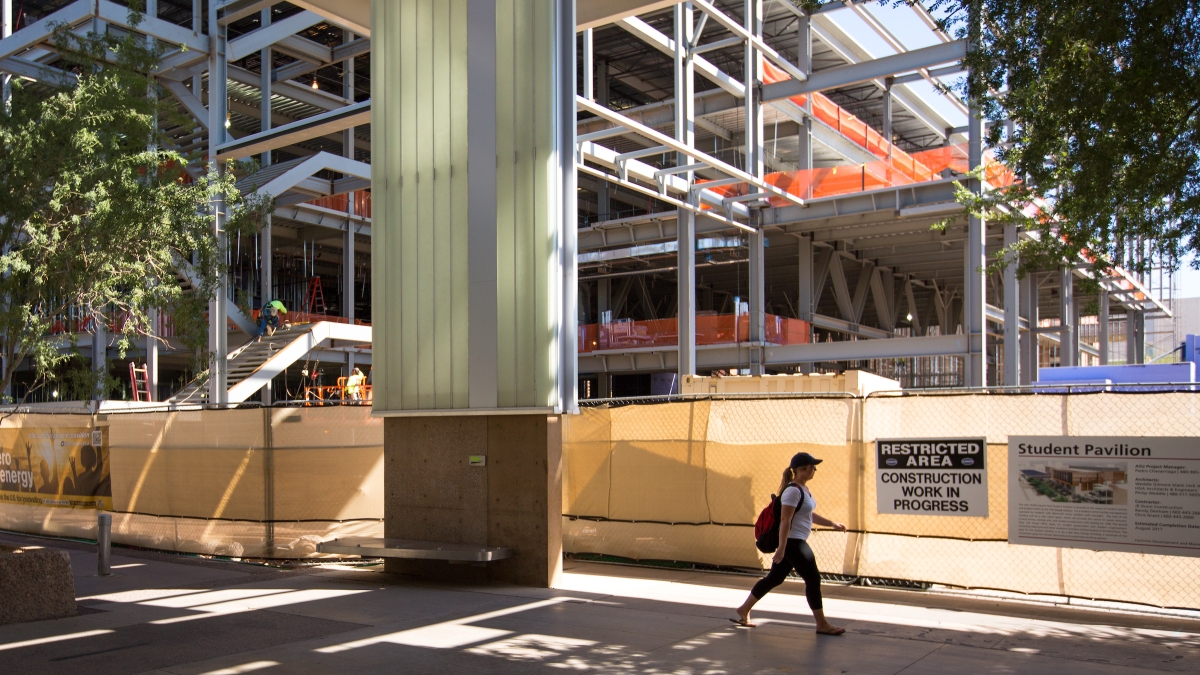As the new Student Pavilion rises on ASU’s Tempe campus, much is being touted about its green qualities. “Net zero energy,” “zero waste’” and “90 percent project diversion,” proclaim fabric posters on the fence surrounding the construction site.
The building is designed to achieve a LEED (Leadership in Energy & Environmental Design) Platinum ranking, the highest ranking of efficiency by the U.S. Green Building Council. It also will be ASU’s first “net zero energy building,” meaning it will use no more energy than can be produced on site annually.
But there is another side to the greening of new building construction at ASU.
The bonds used to fund the construction of the Student Pavilion and the Biodesign C building are “green bonds.” These bonds are a relatively new finance instrument that allows investors to invest directly in projects identified as promoting environmental sustainability on ASU’s campuses, said Joanne Wamsley, vice president of finance and deputy treasurer.
This is the second time green bonds have been used to fund ASU building construction. The first, in 2015, provided the funding for the Beus Center for Law and Society, the new building on the downtown campus that houses the Sandra Day O'Connor College of Law and other organizations.
Wamsley said ASU’s green bonds have enjoyed strong investor interest from insurance companies, investment companies and individual investors.
“These bonds call attention to our on campus sustainability efforts,” Wamsley explained. “They show that sustainability is a core value of the university.”
For the Student Pavilion, to be a net zero energy building means it will showcase the university’s goals for carbon neutrality and sustainable systems, Wamsley said.
The Student Pavilion will be a 74,650-square-foot student-centric facility. On the first floor of the building will be event space for up to 1,200 people, which can be reconfigured into three smaller spaces. The second floor will include space for student government and student organizations, and the third floor will include classrooms and house other academic functions.
The new 74,650-square-foot Student Pavilion, rising on the Tempe campus just northeast of the Memorial Union, will provide new event space, office space for student government and student organizations, and classrooms. The goal for the structure is to be a net zero energy building and be certified LEED Platinum. Construction began in March and is expected to be completed next August. Photos by Charlie Leight/ASU Now
Green features of the building include:
- Water efficiency achieved through water-efficient landscaping, bioswales — landscaping features used to collect and filter stormwater — for landscape irrigation and purple pipe installation for future interior reclaimed-water use.
- Energy and atmosphere strategies including implementation of full rooftop photovoltaic solar cells, high-efficiency HVAC system, chilled beams and a high-performance building exterior.
- Materials and resources, including use of recycled and regionally sourced materials and a 90-percent-plus construction waste diversion from landfills.
- Indoor environmental quality will be achieved using low-emitting materials, LED energy-efficient lighting, interior day lighting and solar tubes to draw in natural daylight.
The Biodesign C building, which recently began excavation just east of the Biodesign complex, will be a multi-functional research building that will add about 188,000 square feet of space. It will include a mix of wet and dry lab space, lab casework and research support space. The five-story-plus-basement building will promote research “neighborhoods” that foster collaborative research and maximize opportunities to advance ASU research.
Green features of Biodesign C include:
- Water efficiency achieved through design measures to reduce water usage of laboratory equipment, as well as the indirect water usage associated with building cooling.
- Energy and atmosphere strategies like advanced HVAC and energy-recovery systems designed to optimize energy performance, chilled beams and a high-performance building exterior.
- Indoor environmental quality will be achieved through use of low-emitting materials, high-performance laboratory fume hoods and energy-efficient lighting with daylight and occupancy controls.
The building is being designed to meet, at a minimum, LEED Silver certification.
In all, Wamsley said the recent green bond sale to fund these buildings provided about $160 million, making both buildings 100 percent funded through the green bond sale.
More Science and technology

ASU professor breeds new tomato variety, the 'Desert Dew'
In an era defined by climate volatility and resource scarcity, researchers are developing crops that can survive — and thrive — under pressure.One such innovation is the newly released tomato variety…

Science meets play: ASU researcher makes developmental science hands-on for families
On a Friday morning at the Edna Vihel Arts Center in Tempe, toddlers dip paint brushes into bright colors, decorating paper fish. Nearby, children chase bubbles and move to music, while…

ASU water polo player defends the goal — and our data
Marie Rudasics is the last line of defense.Six players advance across the pool with a single objective in mind: making sure that yellow hydrogrip ball finds its way into the net. Rudasics, goalkeeper…


